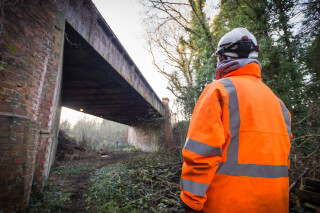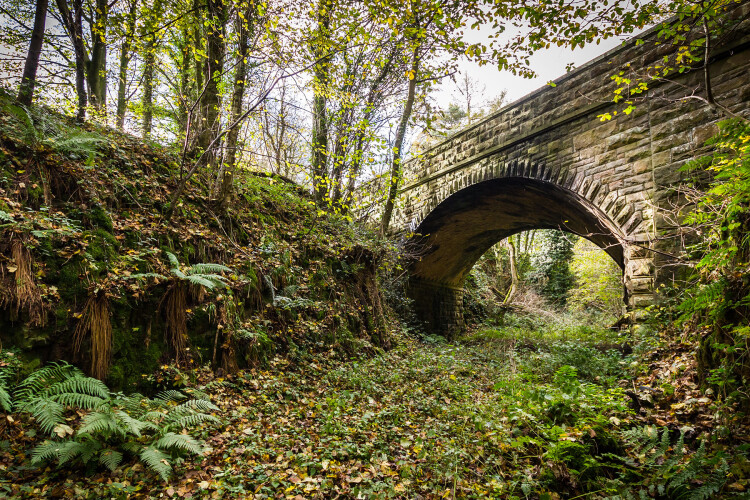According to campaigners, hundreds of railway structures are being got rid of when they could be used for cycle paths or country walks.
Highways England has responsibility for managing the Department for Transport’s Historical Railways Estate (HRE) – a collection of around 3,200 bridges, tunnels and viaducts, some of which carry or span routes earmarked for walking and cycling, or for reopened railways and extensions to heritage lines.
It has a £10m annual budget to inspect and, where necessary repair, old structures. However, in a strategic report from 2016, Highways England set out its preference to “significantly reduce the level of liability and risk to the HE and DfT” through a move to demolition and infilling. The number of structures within the Historical Railways Estate would be reduced by 10-15% (320-480 structures), it said. To fund this work, the HRE budget is being quadrupled to a typical annual figure of £41m.
But according to The HRE Group – an alliance of engineers, cycling campaigners and greenway developers – no assessment is being made as to the strategic value of the affected structures for future transport provision. It says that Highways England is avoiding scrutiny of the normal planning processes by using permitted development powers.
Highways England has been undertaking occasional bridge infilling projects since it took over responsibility for the HRE in 2013. At Chilcompton in Somerset, for example, it blocked a potential extension to a line operated by the Somerset & Dorset Railway Heritage Trust, despite Mendip District Council having a policy that protects the former trackbed.
John Baxter, a member of the Trust’s board, said: “We only heard about the plans second-hand and not long before permission was given to carry out the works. We regarded this as a serious oversight and we would have submitted an objection if we had received earlier notification. It has always been our intention to rebuild as much of the line towards Shepton Mallet as possible.
“Our bridge inspector, who has over 30 years’ experience with such bridges in the heritage sector, reported that the structure had a few minor defects – the sort you would expect of a bridge that was 140 years old – but there was absolutely no safety justification for what Highways England was proposing.
“Their internal brief appears to be one where the consultative process is simply not wide enough to encompass all the people that matter and to get rid of every liability they can without any thought whatsoever of the consequences to rail, rambling or cycling organisations that could take over the structures.
“With this huge increase in budget, it seems they’re now intent on finishing off what Dr Beeching started.”
Highways England insists, however, that its actions are based on public safety rather than short-term economics.

A Highways England spokesperson said: “To maintain the safety of communities living near to Historic Railway Estate structures, and the drivers who use the roads that cross them, we are planning to infill 115 bridges and remove 15 structures over the next five years.
“Most of the bridges earmarked for infilling are over 100 years old and were never designed to carry the weight of modern traffic.
“Local highway authorities have responsibility for applying weight restrictions, closing the roads, or restricting traffic. Around 200 of the public road bridges managed by HE/HRE have failed their most recent structural assessment (BD21) but haven’t had any restrictions implemented. Therefore, our planned infilling is the safest and most appropriate option and will maintain access across the structure.

“Ten of the 15 removals are abutments which had their bridge span removed several decades ago and no longer serve a purpose.
“We’ve contacted all local authorities affected to advise them of our plans and to see if they have any use for the structures. In addition, we have arranged for seven structures to be transferred to local authorities which aspire to use them for cycle routes.”
The full programme of demolition and infilling schemes looks set to create a host of local controversies, with arguments about the actually risks presented and the value of potential amenity being lost.
The HRE Group has written to transport minister Chris Heaton-Harris expressing its concerns about Highways England’s new approach to managing the Historical Railways Estate.
It has asked for assurances that “no HRE structures will be demolished or infilled without assessments first being undertaken of each scheme’s impact on proposed or potential reuses of the relevant disused railway alignment” It asks that Highways England engage with normal planning processes to ensure that all proposals are subject to effective and appropriate scrutiny rather than bypass local democracy with permitted development rights.
Got a story? Email news@theconstructionindex.co.uk



